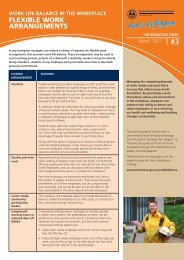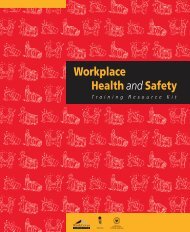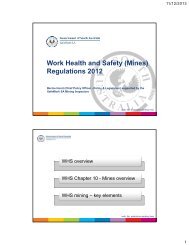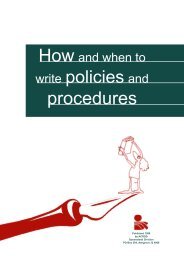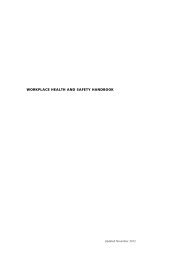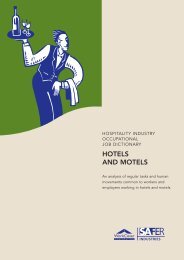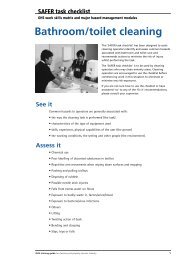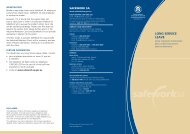Alcohol Drugs Workplace Alcohol Drugs Workplace - SafeWork SA ...
Alcohol Drugs Workplace Alcohol Drugs Workplace - SafeWork SA ...
Alcohol Drugs Workplace Alcohol Drugs Workplace - SafeWork SA ...
Create successful ePaper yourself
Turn your PDF publications into a flip-book with our unique Google optimized e-Paper software.
8<br />
4. CONTROL STRATEGIES<br />
While there is no single way to address the problem of alcohol and other drugs at the<br />
workplace, there are a number of control strategies that may be adopted. Deciding upon<br />
which strategy to adopt will depend on the extent of alcohol and other drug use, the<br />
nature of the industry and the size and resources of the business. Any strategy should be<br />
tailored to meet the needs of that workplace. Information and education about alcohol and<br />
other drugs should form part of any strategy.<br />
The aim of the strategy should be to eliminate or reduce alcohol and other drug related<br />
harm as far as practicable. This objective should be achieved through a three-tiered<br />
approach:<br />
• preventing harm through such steps as providing information and education;<br />
• management of hazards through introducing procedures for dealing with affected<br />
persons at the workplace; and<br />
• provision in the strategy for the return to usual work duties of affected employees.<br />
4.1 Policy on alcohol and other drugs at the workplace<br />
One approach to managing alcohol and other drugs is to establish a policy with supporting<br />
procedures that take into consideration the specific circumstances of the workplace.<br />
Section 3, which discusses “risk factors”, provides guidance on determining an appropriate<br />
strategy by assessing the risks at your workplace.<br />
The development of a policy provides an opportunity to develop management strategies<br />
dealing with a range of alcohol and other drug related issues.<br />
• The policy should outline the organisation’s aims in relation to alcohol and other drug<br />
use with the objective being the reduction of the hazards and risks associated with<br />
alcohol and other drug use.<br />
• The “supporting procedures” should provide the strategies and action plans to meet this<br />
objective.<br />
4.1.1 Why develop a policy?<br />
There are a number of reasons why it may be appropriate to develop a workplace policy on<br />
alcohol and other drugs.<br />
An employer may be found in breach of the general duty to provide a safe workplace if<br />
injury or harm is suffered as a result of alcohol or other drug use (Refer to Section 20 of<br />
the Act). Having a clearly defined policy with supporting procedures is required to be in<br />
place and will assist the employer to provide a safe workplace and manage drug and<br />
alcohol related issues in the workplace.<br />
The existence of a policy also provides a means of informing employees and other people<br />
at the workplace about what behaviour is acceptable in relation to alcohol and other drugs.<br />
Having an alcohol and other drug policy also demonstrates management commitment to a<br />
healthy and safe workplace.<br />
It may be good practice to have a policy even if alcohol and other drugs do not pose a<br />
current risk at a workplace. It is important, however, that all workplace health and safety<br />
policies, including alcohol and other drug policies, are prioritised according to the hazards<br />
present and perceived level of risk at your workplace.<br />
Guidelines for Addressing ALCOHOL & OTHER DRUGS IN THE WORKPLACE



